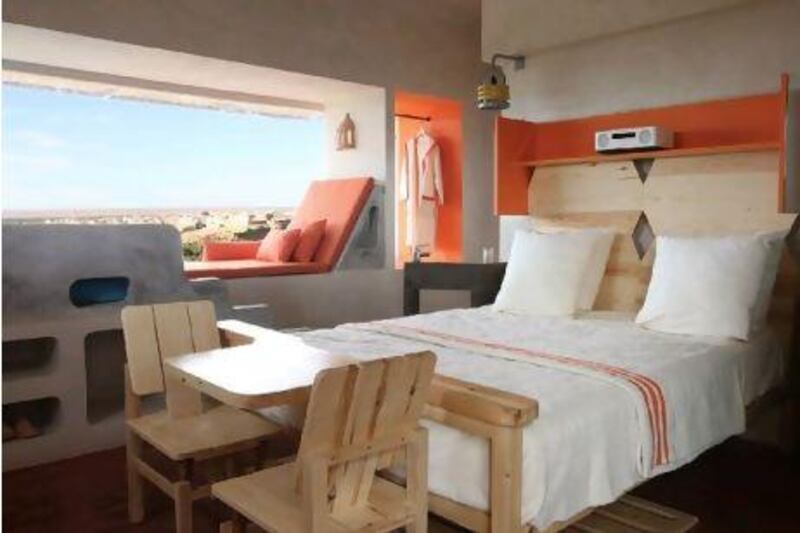At a time of heightened sensitivity concerning ethnic minorities in France, following the shootings of Jewish children and Muslim soldiers in the midst of an inflamed presidential campaign, one might be forgiven for thinking that it's not a good time to risk giving offence. However, the organisers of the new exhibition Le Corps Découvert (The Body Revealed) at Paris's Institut du Monde Arabe do not believe the show will be perceived as provocative.
"That is not at all our intention," says Hoda Makram-Ebeid, one of the show's two curators. "We want this show to break down clichés concerning the Arab world, but we're not looking for controversy. The artists on show are of all ages, from all over the world. The immense variety and multiplicity of the work demonstrates that it is impossible to lump together 'Arabic artists' or Arab art. They're looking at a problematic – that of the body – which interests everyone today and their work is relevant to people of all different backgrounds."
Coinciding with the 25th anniversary of the celebrated institute, this colourful mixed-media show of more than 200 works from 100 years of art from Arab countries is spread over two floors and addresses a hitherto taboo subject: the depiction of the body in Arabic art. Historically, art from the Arab world has focused on floral, vegetal and geometric motifs and calligraphy. The arabesque in Islamic art is often used to symbolise the transcendent nature of God but representations of the human body have generally been avoided as they are considered by many Muslims to be a form of idolatry.
Nevertheless, as this exhibition goes to show, the body, contrary to popular belief in the west, has long been present in the work of certain Arabic artists and occupies an increasingly important place in the work of contemporary artists.
"The body started to appear in the work of Arabic artists when they learnt how to paint, or how to paint in the manner of European painters," explains Makram-Ebeid. "At the start of the 20th century, it wasn't unusual for the privileged few to travel to Europe to complete their education – this went for lawyers as well as artists. Their education included the 'grand European' tour during which they would spend time studying with European masters. 'Pioneer' artists, such as the Lebanese Khalil Saleeby, Georges Daoud Corm and Moustafa Farroukh or the Egyptian Georges Hanna Sabbagh, opened up a dialogue with their European contemporaries. Of course, these artists had to come to terms with the 'Oriental' stereotypes they encountered in the west and certain of them, such as Mahmoud Saïd, even went so far as to appropriate and incorporate these stereotypes into their work."
Instead of a systematic chronological approach, the curators have chosen to highlight certain repetitive themes that recur in the artists' work – such as beauty, suffering, desire. It becomes clear that if 100 years ago Arabic artists were reluctant to put the nude at the centre of their work, over the past 20 to 30 years, since contemporary art has become less of a regional and more of a global affair, the body appears with increasing frequency. The curators suggest that if the nude constitutes a sort of "blind spot" for many monotheist religions, the grip of religion on a community might precisely produce that sort of art of which the religion disapproves. The way in which these artists tackle the subject of the nude may be their way of responding to what they perceive to be as unwelcome constraints.
"At the same time, these artists are just addressing a subject that fascinates everyone at the moment: the body is a fashionable topic and there's no reason why Arabic artists should not also be interested," says Makram-Ebeid.
The work of contemporary artists shows how they are both trying to free themselves of the shackles of the past while also shedding prejudice. The Iraqi-Canadian photographer Tamara Abdul Hadi explores masculine identity through images of Arab men from different corners of the globe. Many of the artists use self- portraiture as a means of questioning identity. Egyptian Youssef Nabil examines the fragility of the physical being and the passage of time, while French-Moroccan artist Mehdi-Georges Lahlou looks at the relation between the sexual body and identity, using a religious aesthetic.
The exhibition ties in nicely with the freshly stated aims of the Institut du Monde Arabe. Inaugurated in 1987 by President Mitterand and financed by France and the 22 Arab countries of the Arab League, the IMA's 25th anniversary has been the occasion for a complete upheaval of the original display. Previously focused on the Islamic art of its sponsor countries, the permanent display has been reorganised to include the pre-Islamic past of Arab countries. Along with a renewed determination to provide a forum for the display of contemporary Arab art, the institute's broader focus on Arab history and, through this exhibition, the nature of Arab identity, is a welcome change at a time when stereotypes, more than ever, need to be confronted.
• Le Corps Découvert opens today and continues until July 15. For more information visit www.imarabe.org
Follow
Arts & Life on Twitter
to keep up with all the latest news and events
[ @LifeNationalUAE ]





